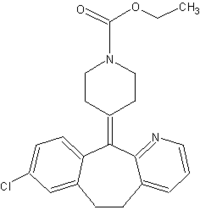Claritin
Loratadine is a drug used to treat allergies. It is marketed by Schering-Plough under several trade names such as Claritin®, Clarityn® or Claratyne® depending on the market, and by Wyeth as Alavert. It is also available as a generic. Its active metabolite, desloratadine, is also on the market, though loratadine itself is the only drug of its class available over the counter (at least in the US and UK) as of 2005. more...
It is sometimes combined with pseudoephedrine to add a decongestant aspect to the treatment, making it somewhat useful for colds as well as allergies.
Available forms
Loratadine is available as tablets and oral suspension, and also in combination with pseudoephedrine. Also available are quick-dissolving tablets, which are advertised as being faster to get into one's system but which require special handling to avoid degrading in the package.
Mechanism of action
Loratadine is a tricyclic antihistamine, which has a selective and peripheral H1-antagonist action. It has a long-lasting effect and does not cause drowsiness because it does not readily enter the central nervous system.
Pharmacokinetics
Loratadine is rapidly absorbed from the gastro-intestinal tract and it has rapid first-pass hepatic metabolism. Loratadine is almost totally bound to plasma proteins. Its metabolite, desloratadine (descarboethoxyloratadine), is also active, but binds to plasma proteins only moderately. The half-life of loratadine is on average 8 hours, and its metabolites 28 hours. About 40% is excreted as conjugated metabolites into the urine and similar amount into the feces. Traces of unmetabolised loratadine can be found in the urine.
Recommended dosage
- Adults and children 15+ years: 10mg once every 24 hours.
- Children 2-14 years:
- Bodyweight above 30kg: 10mg once every 24 hours.
- Bodyweight below 30kg: 5mg once every 24 hours.
(From product packaging for Clarityn tablets.)
Side-effects
Most common side-effects are fatigue, drowsiness, dry mouth, headache, and gastrointestinal disturbances.
Loratadine vs. desloratadine
A November 2003 article published in the journal American Family Physician about the safety, tolerability, effectiveness, price, and simplicity of desloratadine concluded the following:
- Desloratadine is similar in effectiveness to fexofenadine and would be expected to produce results similar to loratadine and other nonsedating antihistamines.Thus Desloratidine is of faster onset of action than Loratidine as the Loratidine is activated in the liver into Desloratidine (which was introduced into the american market under the name Aerius by Schering Plough corporation). However, it may be an option for patients whose medical insurance no longer covers loratadine if the co-pay is less than the cost of the over-the-counter product.
External links and references
- Desloratadine for Allergic Rhinitis, a November 2003 article from American Family Physician
- Packaging directions in PDF Format. Product Packaging for Claritin 24 hour tablets. URL accessed on January 3, 2005.
Read more at Wikipedia.org



